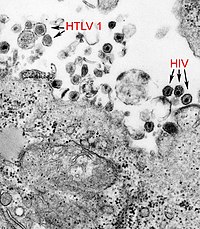
Photo from wikipedia
Objective We evaluated changes of HTLV-1 proviral loads (PVLs) during treatment for rheumatoid arthritis (RA) and investigated whether these changes affect the clinical course in HTLV-1-positive RA patients. Methods A… Click to show full abstract
Objective We evaluated changes of HTLV-1 proviral loads (PVLs) during treatment for rheumatoid arthritis (RA) and investigated whether these changes affect the clinical course in HTLV-1-positive RA patients. Methods A total of 41 HTLV-1-positive RA patients were analyzed. Their clinical picture including disease activity [Disease Activity Score in 28 joints-erythrocyte sedimentation rate (DAS28-ESR), DAS28-CRP, simplified disease activity index (SDAI), and clinical disease activity index (CDAI)] and comorbidity were evaluated over a 2-year period. PVLs from peripheral blood mononuclear cells were investigated by real-time polymerase chain reaction (PCR). We investigated whether HTLV-1 PVLs is altered, or which clinical characteristics affect changes of HTLV1-PVLs during 2-year treatment. Results Clinical disease activity was not changed during the 2-year observational period. The mean HTLV-1 PVL value change from baseline to 2 years was -1.2 copies/1000 PBMCs, which was not statistically significant. No baseline clinical characteristics influenced changes in HTLV-1 PVL. However, a numerical change of HTLV-1 PVLs was increased in 4 patients initiating the new biological/targeted synthetic disease-modifying antirheumatic drugs (b/tsDMARDs) at 2−10 months after starting the new b/ts DMARDs (numerical increase was 24.87 copies/1000 PBMCs). Infection occurred in 4 patients, and 3 of those patients showed an increased HTLV-1 PVL. Univariate analysis revealed an association between increase of HTLV-1 PVL and incidence of infection. Conclusions Over 2 years, HTLV-1 PVL did not significantly change in our HTLV-1-positive RA patients. Individual changes in HTLV-1 PVL were correlated with incidence of infection but not disease activity which indicate that we may take precaution toward infection at the uptick of HTLV-1 PVL in HTLV-1-positive RA patients.
Journal Title: Frontiers in Immunology
Year Published: 2022
Link to full text (if available)
Share on Social Media: Sign Up to like & get
recommendations!